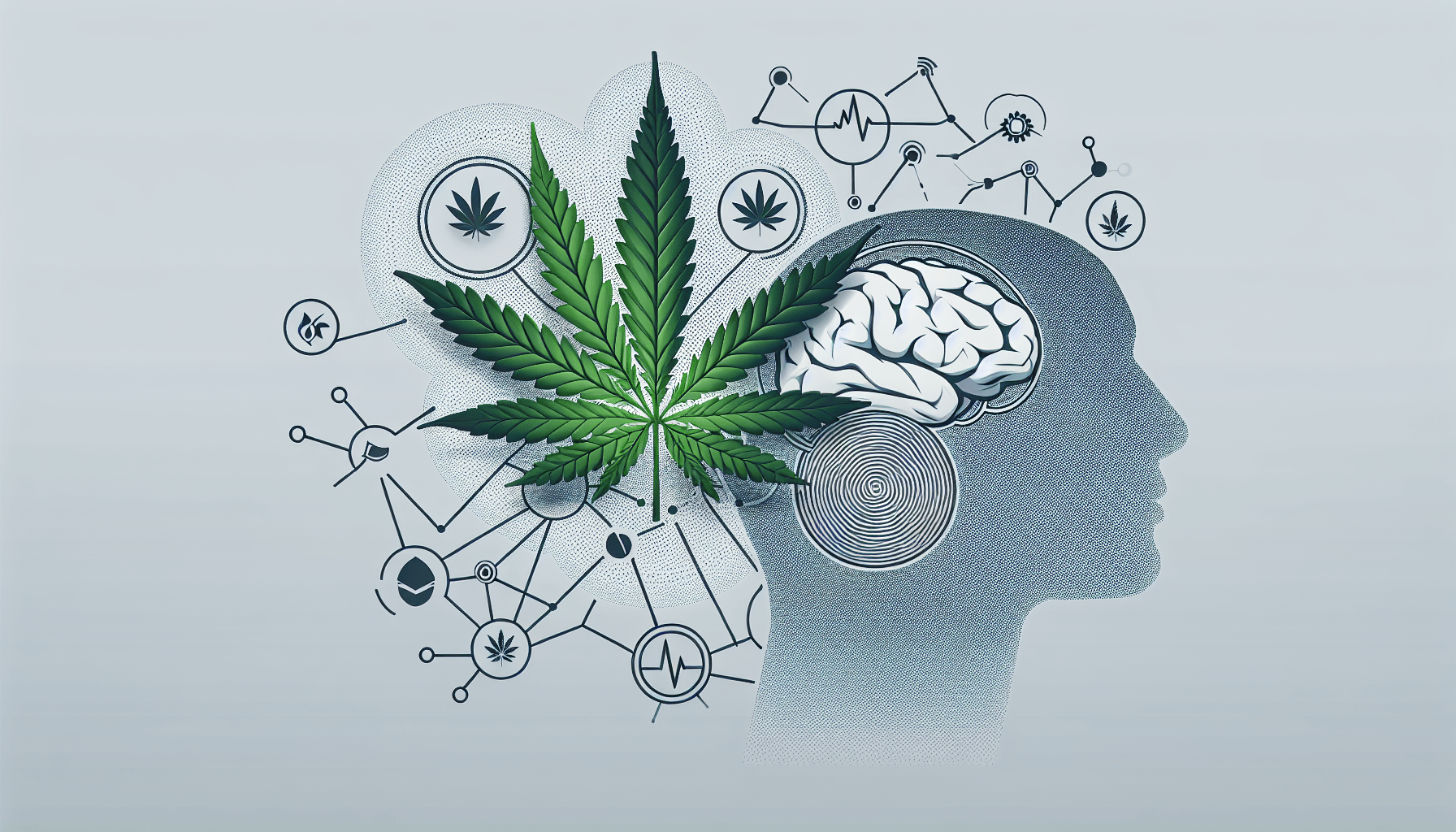Intriguing and thought-provoking, this article explores the impact of cannabis on symptoms of Post-Traumatic Stress Disorder (PTSD). Delving into the complexities of this condition, we delve deeper into the question of how cannabis interacts with PTSD symptoms. Find out how this controversial plant may offer relief for those grappling with the aftermath of trauma, and discover the potential benefits and drawbacks that come with its use. Discover a new perspective on the intersection between cannabis and mental health, and gain insight into the ongoing research surrounding this topic.
Overview of PTSD
Definition of PTSD
Post-Traumatic Stress Disorder (PTSD) is a psychiatric disorder that can develop in people who have experienced or witnessed a traumatic event. It is characterized by persistent and intense symptoms that can significantly impact a person’s daily life. These symptoms may include flashbacks, nightmares, intrusive thoughts, hypervigilance, avoidance of triggers, and changes in mood and behavior.
Common symptoms of PTSD
The symptoms of PTSD can vary from person to person, but some common symptoms include re-experiencing the traumatic event through distressing memories, nightmares, or flashbacks. Individuals with PTSD may also exhibit avoidance behaviors, such as avoiding certain places, people, or activities that remind them of the trauma. Other symptoms may include persistent negative thoughts or beliefs about oneself or the world, changes in mood or emotional reactivity, and heightened arousal, such as being easily startled or having difficulty sleeping.
Prevalence of PTSD
PTSD can affect individuals of all ages, genders, and backgrounds. According to the National Institute of Mental Health, about 7-8% of the population in the United States will experience PTSD at some point in their lives. The prevalence of PTSD is even higher among certain populations, such as military veterans, who may have experienced combat trauma. It is important to note that PTSD can be a debilitating condition, and seeking appropriate treatment is crucial for recovery and improving quality of life.
Introduction to Cannabis
Definition of cannabis
Cannabis, also known as marijuana, is a plant that contains various chemical compounds called cannabinoids. The two primary cannabinoids found in cannabis are tetrahydrocannabinol (THC) and cannabidiol (CBD). THC is responsible for the psychoactive effects of cannabis, while CBD is non-intoxicating and has been associated with potential therapeutic benefits.
Types of cannabis
There are different strains of cannabis, each with its own unique characteristics. The two main types of cannabis strains are indica and sativa. Indica strains are generally associated with relaxation and are known for their sedative effects, making them suitable for evening or nighttime use. Sativa strains, on the other hand, are often described as energizing and uplifting, making them more suitable for daytime use.
Methods of consumption
Cannabis can be consumed in various ways, and the choice of consumption method may depend on personal preference and desired effects. Smoking, either through joints or pipes, is a traditional method of cannabis consumption. Vaporization involves heating cannabis to a temperature that releases the active compounds without combustion, reducing potential exposure to harmful compounds. Edibles, such as foods or beverages infused with cannabis, offer an alternative method of consumption. Topicals are cannabis-infused products that can be applied directly to the skin for localized relief. Other methods of consumption include tinctures and oils, which are taken orally or sublingually.
Understanding the Endocannabinoid System
Explanation of the endocannabinoid system
The endocannabinoid system (ECS) is a complex signaling system in the human body that plays a vital role in regulating various physiological processes, including mood, pain sensation, appetite, and sleep. It consists of cannabinoid receptors, endocannabinoids (naturally occurring cannabinoids produced by our body), and enzymes responsible for their synthesis and degradation. The ECS helps maintain balance in the body, known as homeostasis.
Role of endocannabinoids in mood regulation
The endocannabinoids produced by our body, such as anandamide and 2-arachidonoylglycerol (2-AG), interact with cannabinoid receptors in the brain and throughout the body to modulate mood and emotional responses. They have been implicated in the regulation of anxiety, stress, and depressive symptoms. When there is an imbalance in the endocannabinoid system, it may contribute to the development of mood disorders, including PTSD.
Effects of cannabinoids on the endocannabinoid system
Cannabinoids found in cannabis, such as THC and CBD, can interact with the cannabinoid receptors in the ECS. THC primarily binds to the CB1 receptors in the brain, producing psychoactive effects and potentially affecting mood and cognition. CBD, on the other hand, does not directly bind to cannabinoid receptors but can modulate their activity, leading to potential therapeutic effects. By interacting with the ECS, cannabinoids may influence mood regulation and potentially offer benefits for individuals with PTSD.
Potential Benefits of Cannabis for PTSD
Reduction of anxiety
Many individuals with PTSD experience significant levels of anxiety, and cannabis has been suggested to provide relief. THC, in particular, has been shown to have anxiolytic properties, meaning it can reduce anxiety. However, it is important to note that high doses of THC may exacerbate anxiety in some individuals, so finding the right balance and strain is crucial.
Improvement in sleep patterns
Sleep disturbances are common among individuals with PTSD, and cannabis has been reported to have potential benefits in improving sleep patterns. Indica strains, known for their sedative effects, may help promote relaxation and better sleep quality. However, long-term use of cannabis for sleep may lead to dependence or tolerance, so it should be used judiciously and under medical supervision.
Alleviation of intrusive thoughts
Intrusive thoughts and flashbacks are hallmark symptoms of PTSD, and some studies suggest that cannabis may help alleviate these symptoms. THC has been shown to potentially disrupt the retrieval of traumatic memories, providing some relief from intrusive thoughts. More research is needed, however, to fully understand the mechanisms and long-term effects.
Enhancement of mood
Cannabis, particularly strains with higher CBD content, has been associated with potential mood-enhancing effects. CBD has been studied for its anti-depressant and anxiolytic properties, which may be beneficial for individuals with PTSD who struggle with mood regulation. However, it is important to emphasize that individual responses may vary, and personalized treatment plans should be developed with medical professionals.
Clinical Studies on Cannabis and PTSD
Overview of existing research
While the potential benefits of cannabis for PTSD are promising, it is important to acknowledge the limitations of current research. The legality and stigma surrounding cannabis have made it challenging to conduct large-scale clinical studies. However, some small-scale studies and anecdotal evidence suggest that cannabis, when used appropriately, may offer relief for certain PTSD symptoms.
Effectiveness of cannabis in managing PTSD symptoms
Several studies have examined the effects of cannabis on PTSD symptoms, including anxiety, nightmares, and sleep disturbances. A study published in the Journal of Clinical Psychopharmacology found that individuals with PTSD who used cannabis experienced a reduction in intrusive thoughts and nightmares. Another study published in the Journal of Psychopharmacology reported a significant reduction in anxiety symptoms among participants with PTSD who used cannabis.
Controversies and limitations of current studies
While these studies show promising results, it is crucial to interpret the findings with caution due to the limitations of available research. Current studies often rely on self-reported data, making it difficult to establish causation or determine the optimal dosage and strains for specific symptoms. Additionally, individual responses to cannabis can vary, and some individuals may experience adverse effects or exacerbation of symptoms. Further research is needed to address these controversies and provide more comprehensive guidelines for cannabis use in PTSD management.
Different Strains and Cannabinoid Ratios
Indica vs. sativa strains
Indica and sativa are the two main types of cannabis strains, and they have distinct characteristics. Indica strains are typically associated with relaxation, sedation, and body effects. They may be beneficial for individuals with PTSD who experience physical tension or have difficulty sleeping. Sativa strains, on the other hand, are often described as uplifting and energizing, potentially helping with daytime mood management. Understanding the differences between these strains can guide individuals in choosing the most appropriate strain for their specific needs.
CBD-dominant vs. THC-dominant strains
CBD-dominant strains are those with higher CBD content and lower THC content. These strains are associated with potential therapeutic benefits, including anxiety reduction and mood enhancement, without the psychoactive effects of THC. THC-dominant strains, on the other hand, contain higher levels of THC and may produce stronger psychoactive effects. Finding the right balance between CBD and THC is crucial to mitigate potential risks and enhance the therapeutic effects of cannabis for PTSD.
Significance of terpenes
Terpenes are organic compounds found in cannabis that contribute to its aroma and potential therapeutic effects. They may also interact with cannabinoids, enhancing their effects through the entourage effect. For example, the terpene myrcene has sedative properties and may enhance the relaxing effects of indica strains, while limonene has uplifting and mood-enhancing properties. Understanding the different terpenes and their potential effects can further guide individuals in selecting strains that align with their desired outcomes.
Methods of Cannabis Consumption for PTSD
Smoking/Inhalation
Smoking or inhaling cannabis is a common method of consumption. It involves inhaling the smoke from combusted cannabis flowers or concentrates. Smoking offers rapid onset effects, but it may also have potential risks to lung health due to the inhalation of smoke and other harmful byproducts. It is important to consider personal respiratory health and choose this method cautiously.
Vaporization
Vaporization is an alternative to smoking that involves heating cannabis to a temperature that releases the active compounds without combustion. This method significantly reduces the potential exposure to harmful combustion byproducts. Vaporizers come in various forms, including portable handheld devices and tabletop units, offering a convenient and potentially safer option for inhalation.
Edibles
Edibles are cannabis-infused foods or beverages that are ingested orally. They come in various forms, such as gummies, chocolates, or drinks. Edibles offer a discreet and convenient method of consumption, and their effects tend to last longer than smoking or vaporization. However, it is important to be mindful of dosage and start with a low dose, as edibles can have delayed onset and varying potency.
Topicals
Topicals are cannabis-infused products, such as creams, lotions, or balms, that are applied directly to the skin. They provide localized relief and can be beneficial for individuals with skin conditions or localized pain. When using topicals for PTSD symptoms, they can be applied to areas of tension or discomfort, potentially providing relief without the psychoactive effects associated with other methods of consumption.
Tinctures and oils
Tinctures and oils are liquid cannabis extracts that are typically taken sublingually (under the tongue) or added to food and beverages. They offer a discreet and precise method of consumption and allow for easy dose adjustment. Tinctures and oils can be particularly beneficial for individuals who prefer not to smoke or have difficulty with oral ingestion.
Potential Risks and Side Effects
Psychiatric effects
While cannabis has potential therapeutic benefits for PTSD, it can also have adverse psychiatric effects, especially in high doses or in individuals prone to anxiety or psychosis. THC, in particular, can induce or exacerbate anxiety, paranoia, or psychosis in susceptible individuals. It is crucial to start with low doses, choose strains with appropriate cannabinoid ratios, and closely monitor one’s response to cannabis to mitigate potential psychiatric risks.
Addiction potential
Cannabis use disorder, characterized by a pattern of problematic cannabis use, is a potential risk associated with cannabis consumption. While the risk of addiction is relatively lower compared to substances like alcohol or opioids, some individuals may develop dependence or experience withdrawal symptoms upon discontinuation. It is important to use cannabis responsibly and seek professional help if there are concerns about addiction or problematic use.
Interaction with prescription medications
Cannabis can interact with certain prescription medications, potentially affecting their efficacy or increasing the risk of adverse effects. It is crucial to inform healthcare providers about cannabis use to ensure safe and appropriate treatment. Some medications, such as benzodiazepines or opioids, may have synergistic effects with cannabis, increasing sedation or respiratory depression. It is important to discuss potential drug interactions with a healthcare provider.
Long-term effects
The long-term effects of cannabis use, particularly in the context of PTSD, are still not fully understood. While some studies suggest potential benefits, such as mood regulation and improved sleep, there are also concerns about the potential impact on cognitive function, mental health, and respiratory health. Long-term cannabis use may also contribute to the development of cannabis use disorder. More research is needed to elucidate the long-term effects and provide evidence-based guidelines for cannabis use in PTSD management.
Legal Considerations
Current legal status of cannabis
The legal status of cannabis varies depending on the country and jurisdiction. In some places, cannabis is fully legalized for recreational and medical use, while in others, it remains illegal or decriminalized. It is essential to be aware of the laws and regulations regarding cannabis in one’s location to ensure compliance and avoid legal consequences.
Medical cannabis programs
In some countries or states where cannabis is not fully legalized, medical cannabis programs may exist. These programs allow individuals with qualifying medical conditions, including PTSD, to access cannabis for therapeutic purposes. Medical cannabis programs often require certification from healthcare providers and may have specific guidelines for dosage, strain selection, and consumption methods.
Implications for veterans
Veterans, who may have a higher prevalence of PTSD due to their experiences in the military, face specific challenges and considerations when it comes to cannabis and PTSD. In some countries, veterans may have access to specialized medical cannabis programs or have additional support and resources available. It is important for veterans to engage with healthcare professionals and veterans’ organizations to navigate the legal and medical landscape and make informed decisions regarding cannabis use.
Personal Experiences and Testimonials
Anecdotal evidence from PTSD patients
While anecdotal evidence cannot replace rigorous scientific research, many individuals with PTSD have reported personal experiences and positive outcomes from using cannabis. These testimonials often highlight the potential benefits of cannabis in reducing anxiety, improving sleep, and alleviating PTSD symptoms. It is important to recognize that individual responses to cannabis can vary, and what works for one person may not work for another. Personal experiences should be considered as part of the broader discussion around cannabis and PTSD.
Individual stories and perspectives
Many individuals have shared their personal stories and perspectives on using cannabis for PTSD. These stories often highlight the challenges faced by individuals with PTSD and the potential role cannabis has played in their treatment and overall well-being. While these stories provide valuable insights into the impact of cannabis, it is important to view them in conjunction with scientific research and medical advice to make informed decisions.
Overall, while cannabis holds promise as a potential therapeutic tool for individuals with PTSD, more research is needed to understand its efficacy, optimal dosing, and potential risks. It is crucial to approach cannabis as a complementary treatment and to work closely with healthcare professionals to develop individualized treatment plans tailored to each person’s needs and circumstances.





